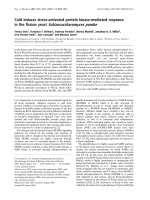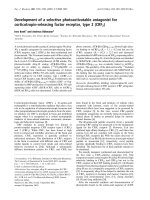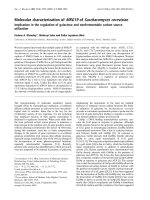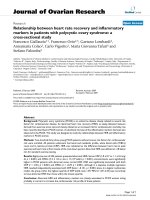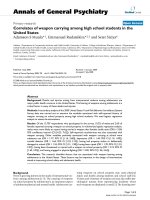Báo cáo y học: "Relationship between inflammatory markers, metabolic and anthropometric variables in the Caribbean type 2 diabetic patients with and without microvascular complications" pptx
Bạn đang xem bản rút gọn của tài liệu. Xem và tải ngay bản đầy đủ của tài liệu tại đây (319.93 KB, 7 trang )
BioMed Central
Page 1 of 7
(page number not for citation purposes)
Journal of Inflammation
Open Access
Research
Relationship between inflammatory markers, metabolic and
anthropometric variables in the Caribbean type 2 diabetic patients
with and without microvascular complications
B Shivananda Nayak*
1
and Lesley Roberts
2
Address:
1
Department of Preclinical Sciences, Biochemistry unit, The University of the West Indies, Trinidad and
2
Department of Medicine,
Nephrology unit, EWMSC, Trinidad
Email: B Shivananda Nayak* - ; Lesley Roberts -
* Corresponding author
Abstract
Background: Serum sialic acid and C reactive protein are the markers for inflammation. The main
objective of this study was to determine the sialic acid level in Caribbean type 2 diabetic patients
with and without microvascular complications and its relationship with metabolic and
anthropometric variables.
Research design and methods: The Caribbean subjects aged 15–60 years with type 2 diabetes
were recruited for the study. Fasting venous blood samples were collected from 162 subjects of
which 44 were healthy individuals, 44 were of type 2 diabetes, 44 were of type 2 diabetes with
nephropathy and 30 were of diabetes with retinopathy. Simultaneously urine samples were also
collected from each of the subjects. All the blood samples were processed for lipid profile, glucose,
HbA1
C,
C-reactive protein and sialic acid. The urine samples were analysed for sialic acid and
microalbumin.
Results: Serum sialic acid concentrations were significantly higher among diabetic subjects (66.0 ±
11.7 mg %) as compared to controls (55.2 ± 8.3 mg %). There was a significantly increasing trend
of serum sialic acid with severity of nephropathy (71.6 ± 23.6 mg %) and degree of urinary albumin
excretion (794.3 ± 805.9). The diabetic retinopathy patients also demonstrated significantly higher
values of serum sialic acid (77.9 ± 29.0) and urine microalbumin (351.1 ± 559.9). Elevated serum
sialic acid microalbumin concentrations were associated with cardiovascular risk factors such as
hypertension, increased waist to hip ratios. (P < 0.05). Sialic acid had no correlation with CRP or
any component of the lipid profile.
Conclusion: The increased serum sialic acid and microalbumin were strongly related to the
presence of microvascular complications like diabetic nephropathy and diabetic retinopathy and
cardiovascular risk factors like hypertension and waist to hip ratios in Caribbean type-2 diabetic
patients. The serum sialic acid may be used as an inflammatory marker and possible indicator of
microvascular complications in type-2 diabetic patients.
Published: 22 December 2006
Journal of Inflammation 2006, 3:17 doi:10.1186/1476-9255-3-17
Received: 30 August 2006
Accepted: 22 December 2006
This article is available from: />© 2006 Nayak and Roberts; licensee BioMed Central Ltd.
This is an Open Access article distributed under the terms of the Creative Commons Attribution License ( />),
which permits unrestricted use, distribution, and reproduction in any medium, provided the original work is properly cited.
Journal of Inflammation 2006, 3:17 />Page 2 of 7
(page number not for citation purposes)
Background
Diabetes Mellitus (DM) is a metabolic disorder of multi-
ple etiologies characterized by chronic hyperglycemia
with disturbances of carbohydrate, fat and protein metab-
olism resulting from defects in insulin secretion, insulin
action or both. In 1999, it was the second leading cause of
death in Trinidad and Tobago with 1306 deaths [1].
According to the World Health Organization, it costs each
diabetic an average of 533 US$ per annum in direct cost
with respect to health care, which is over 300% the
amount a healthy person would have to pay in health care
per annum [2].
The complications of Diabetes Mellitus include cardiovas-
cular disease (CVD) and it has been found that CVD is due
in part to low grade systemic inflammation [3]. In the
Atherosclerosis Risk in Communities (ARIC) study, there
was a positive link between systemic inflammation and
the development of type 2 diabetes, but this link was seen
only in white non smokers. The link was neither seen
among African Americans nor among smokers [4]. How-
ever, in our previous study we found a positive correlation
between inflammatory markers and type 2 diabetes in the
Indian population [5].
Sialic acid is a component of cell membranes [6] and ele-
vated levels may indicate excessive cell membrane dam-
age, but more specifically to the cells of vascular tissue. If
there is damage to vascular tissue, this leads to ischaemia
and this ischaemia is most visible in the smallest blood
vessels, including those of the retina of the eyes, kidneys,
heart and brain. It is this ischaemia that leads to condi-
tions including, but not limited to retinopathy, nephrop-
athy and neuropathy. In addition, sialic acid can be used
as a measurement of the acute phase response because
many of the proteins of the immune response are actually
glycoproteins and these glycoproteins have sialic acid as
the terminal sugar on their oligosaccharide chain [7].
The purpose of this study would be to determine whether
in Caribbean type 2 diabetics, there is a higher level of
sialic acid, which is a marker of acute phase inflamma-
tion. As mentioned before, there have been studies that
have suggested that there is a positive correlation, while
others suggest it is only within certain groups that there is
a positive correlation. It would, therefore, be interesting to
see the results within a multiethnic society such as that of
Trinidadians (Caribbean subjects). In our earlier studies
we found a positive correlation in the Indian population,
this would be of even greater significance in the Caribbean
population due to our multiethnic population, of which
the descendants of East Indian immigrants make up a sig-
nificant portion. If there is proper assessment of cardio-
vascular risk among diabetics here in Trinidad, this would
in turn allow medical practitioners to better manage their
diabetic patients with regards to prevention of complica-
tions and improve not only the life expectancy, but the
quality of life of these patients.
Materials and methods
This was a case-control study [8] comparing the concen-
trations of inflammatory markers and metabolic variables
in the Caribbean population Type 2 diabetes with the con-
centrations of inflammatory markers and metabolic vari-
ables in Caribbean population without diabetes. The
study includes 162 subjects (male and female) of which
44 were of healthy individuals, 44 patients with type 2
diabetes, 44 patients with type 2 diabetes and nephropa-
thy and 30 diabetics with retinopathy. The Caribbean sub-
jects aged 15–60 years with type 2 diabetes were recruited
for the study.
All the subjects were reported in the morning after over-
night fast. Standing height and weight were measured.
Body Mass Index (BMI) defined as weight in kg/height
(meters) squared was calculated and used as an index of
obesity. To determine waist to hip ratio, the standardized
clinician's tape measure was placed around the widest
part of the hips and then placed around the narrowest part
of the waist above the belly button. The ratio was deter-
mined by dividing the waist measurement by the hip
measurement [9]. The blood pressure was measured
according to the standard procedure.
The fasting blood and random urine samples were col-
lected. The red top tubes (without any anticoagulant)
were used to collect the blood samples for the analysis of
sialic acid,, CRP, total cholesterol, triglyceride (TG), low-
density lipoprotein (LDL), high-density lipoprotein
(HDL), and grey top tubes (with fluoride) were used to
collect the sample for glucose estimation. Green top tubes
(with heparin) were used to collect the blood sample for
HbA1c determination. The Blood and urine samples were
kept on ice prior centrifugation. All the serum and urine
samples were stored at -20°C. The lipid profile and sugar
was done with automated instrument. The HbA1
C,
CRP
and urine albumin were analyzed by NycoCard reader
(point of care instrument designed for rapid and reliable
measurements of microalbumin, C – reactive protein and
HbA1c) supplied from JT Rapid diagnostics, Trinidad and
Tobago (Axis Shield PoCAS, Norway, the manufacturer).
The materials supplied included were quality control, test
device, diluents and washing solution.
Serum and urinary sialic acid were measured by a spectro-
photometric assay [10]. In this method 0.15 ml serum (or
urine) was mixed with 3.60 ml of 5% TCA and the tubes
were covered with marbles, and kept in a boiling water
bath for 15 minutes. The tubes were cooled and centri-
fuged for 10 minutes at 2000 g. Taken 1.0 ml of superna-
Journal of Inflammation 2006, 3:17 />Page 3 of 7
(page number not for citation purposes)
tant and mixed with 2.0 ml each of acid reagent and
diphenylamine reagent. Simultaneously standard and
blank were treated in the same way. Mix all the tubes,
cover with marbles and placed in a boiling water bath for
30 minutes. The purple color produced measured on a
spectrophotometer at 540 nm.
Sample specification
The target population was 15–60 year old Caribbean sub-
jects with type 2 diabetes and sample selection was via
stratified random sampling. The inclusion criteria were
15–60 year old Caribbean subjects, both male and female:
a) in good overall health, considered as controls, b) with
Type 2 diabetes and no complications, c) Type II diabetes
with nephropathy. d) Type 2 diabetes with retinopathy.
The exclusion criteria were: a) persons with type 1 diabe-
tes, b) persons who had or recently had any medical con-
dition which could affect concentrations of inflammatory
markers (for instance, cancer), c) persons taking choles-
terol-lowering medication, d) pregnant women and e)
heavy smokers (more than one pack of cigarettes per day).
Demographic data collected were: age, gender and ethnic-
ity. Potential confounding variables were, diet, physical
activity and obesity.
Statistical method
Results were expressed as mean ± SD. Data were analyzed
using the statistical package for social science (SPSS). The
comparisons within and among group were done using
one way ANOVA test. The p value < 0.05 was taken as the
cut off level for significance. Because the distribution of
most variables was not symmetric. Pearson's correlation
test was used for correlation study.
Results
Table 1 shows the relationship between inflammatory
markers, metabolic and anthropometric variables in Car-
ibbean population with type 2 diabetes mellitus. There is
significant difference (p < 0.000) in serum sialic acid con-
centrations between at least two means, hence the null
hypothesis is rejected. Serum sialic acid concentrations
were significantly higher among the diabetic subjects
(66.0 ± 11.7 mg %) as compared to the controls (55.2 ±
8.3 mg %), (p < 0.01). Significant higher values of serum
sialic acid were found among diabetic nephropathy (71.6
± 23.6 mg %) and retinopathy (77.9 ± 29.0) subjects as
compared to the controls (P < 0.000) (Figure 1). The
waist/hip ratio of the diabetic (0.92 ± 0.07), diabetic
nephropathy (0.94 ± 0.06) and diabetic retinopathy (0.93
± 0.09) subjects were significantly higher than the con-
trols (0.86 ± 0.06) (P < 0.000). The systolic blood pressure
was significantly higher in diabetic (144.4 ± 20.5 mmHg),
diabetic nephropathy (160.3 ± 28.0 mmHg) and diabetic
retinopathy subjects (162.8 ± 25.60) when compared to
the controls (123.9 ± 14.5 mmHg) (p < 0.000). Similarly,
triglyceride concentrations were significantly higher
among diabetics (155.4 ± 114.8 mg/dl), diabetic neph-
ropathy (149.4 ± 75.8) and diabetic retinopathy (176.5 ±
93.2) subjects as compared to controls (105.7 ± 65.1 mg/
dl), however the diabetics with nephropathy showed
moderate increase in triglycerides when compared to the
controls. There was not much difference in the LDL values
among the groups. The figure 2 explains the lipid profile
status among the four study groups. It was found that
there were significant increases in fasting blood glucose,
urinary albumin and HbA1c among diabetics (p < 0.05).
There was no significant change in the concentrations of
C reactive protein, urinary sialic acid, HDL, VLDL, choles-
terol and BMI between the four study groups. Serum sialic
acid was significantly correlated with urine microalbumin
(r = 0.484, p < 0.01), waist/hip ratio(r = 0.226, P < 0.05)
and systolic blood pressure(r = .263, P < 0.01) Figures 3
and 4 represents the correlation of sialic acid with waist/
hip ratio and systolic blood pressure respectively
Discussion
Within recent years, there has been considerable interest
and research into sialic acid and its use as a potential
inflammatory marker for diabetes mellitus [11]. Previous
reports have also indicated that serum sialic acid (SSA)
concentrations were associated with an increased risk of
cardiovascular disease in the diabetic population as well
as the presence of micro-vascular diabetes related compli-
cations [12]. Our study primarily focuses on the relation-
ship between sialic acid and metabolic variables. We also
wished to investigate the relationship between sialic acid
and lipid profiles and to determine whether sialic acid
concentrations were increased in patients with diabetes
with and without microvascular complications. Previous
studies have indicated that SSA concentrations are ele-
vated in diabetics (both type 1 and type2) with and with-
out complications, while others have reported no such
correlation [13,14]. Studies have also found that the pres-
ence or absence of this trend may be related to ethnicity
[15].
Our research indicates that there is a significant increase
(p < 0.01) in SSA concentrations in diabetic patients when
compared to the control. This finding was also observed
when patients with diabetic nephropathy and retinopathy
were compared to the controls. It was noted that there was
significant increase in SSA when diabetic group compared
to diabetic retinopathy patients.
Serum sialic acid is a protein bound carbohydrate and
occurs in combination with monosaccharides like galac-
tose and mannose. Ninety percent is bound and almost
none are free [16]. In serum they are generally bound to
Journal of Inflammation 2006, 3:17 />Page 4 of 7
(page number not for citation purposes)
acute phase proteins [17]. There are several possible expla-
nations for the increase in SSA concentrations. Several
research studies have shown that the concentration of
sialic acid in serum is elevated in pathological states when
there is damage to tissue, tissue proliferation and inflam-
mation [16]. Research studies have also indicated that vas-
cular permeability is regulated by sialic acid moieties. The
vascular endothelium carries a high concentration of sialic
acid and hence extensive microvascular damage associ-
ated with non-insulin dependant diabetes mellitus
(NIDDM), could account for its shedding into the circula-
tion. This leads to an increase in vascular permeability and
overall increased SSA concentrations [6,12].
Tissue injury caused by diabetic vascular complications
stimulates local cytokine secretions from cells involved in
the complications such as macrophages and endothe-
lium. This induces an acute phase response which
involves the release of acute phase glycoproteins with
sialic acid from the liver into the general circulation again
leading to increased SSA concentrations [11]. Another
plausible explanation for the increases SSA is that there
may be a difference in the ratio between the two forms of
erythrocyte sialidases which are important in maintaining
the viability of the erythrocyte and its survival in the circu-
lating blood [18].
As expected the difference between SSA concentrations
between diabetes with complications and healthy subjects
were statistically more significant (p < 0.000) than the dif-
ference between diabetics and healthy subjects (p <
0.010). In diabetic nephropathy and retinopathy there is
a further increase in micro vascular damage which may
have resulted in the greater increase in the SSA concentra-
tions observed.
The increase in urine albumin seen in diabetics as com-
pared to the controls can be interpreted as an early sign of
nephrogenic changes in those individuals. The increase in
urine albumin was seen with diabetic nephropathy was
significantly higher than the other group subjects. This
can be attributed to the degradation of the glomerular
basement membranes as well as the increased hyperten-
Serum sialic acid concentration in controls (healthy individu-als), diabetics, diabetics with nephropathy and diabetics with retinopathyFigure 1
Serum sialic acid concentration in controls (healthy individu-
als), diabetics, diabetics with nephropathy and diabetics with
retinopathy.
Table 1: Serum inflammatory markers, metabolic and anthropometric variables in Caribbean Type 2 diabetics with and without
microvascular complications
Variable Controls
(Mean ± SD)
N = 44
Diabetics
(Mean ± SD)
N = 44
Nephropathy
(Mean ± SD)
N = 44
Retinopathy
(Mean ± SD)
N = 30
P value
BMI (kg/m
2
) 27.5 ± 7.34 29.1 ± 9.5 27.1 ± 6.9 28.7 ± 4.2 NS
Waist/hip ratio 0.86 ± 0.061 0.92 ± 0.07 0.94 ± 0.06 0.93 ± 0.094 0.000
Blood pressure (mmHg) 123.8 ± 14.5 144.4 ± 20.5 159.8 ± 6.92 162.8 ± 25.6 0.000
Serum Sialic acid (mg/dl) 55.2 ± 8.3 66.0 ± 11.7 71.6 ± 23.6 77.9 ± 29.0 0.01
Urine Sialic acid (mg/dl) 29.0 ± 15.1 38.5 ± 28.4 35.9 ± 38.9 55.1 ± 47.4 NS
Microalbumin (mg/l) 8.5 ± 12.5 27.9 ± 30.5 794.3 ± 805.9 351.1 ± 559.9 0.05
CReactive protein (mg/l) 2.0 ± 2.0 3.1 ± 4.2 3.5 ± 6.4 3.45 ± 3.8 NS
Cholesterol (mg/dl) 206.7 ± 53.7 189.7 ± 42.2 185.8 ± 61.4 216.0 ± 63.1 NS
Triglycerides (mg/dl) 105.6 ± 65.1 155.4 ± 114.8 149.3 ± 75.8 176.5 ± 93.2 0.01
HDL (mg/dl) 43.8 ± 10.5 44.3 ± 9.1 43.9 ± 10.2 44.8 ± 11.5 NS
LDL (mg/dl) 140.4 ± 53.5 114.3 ± 42.6 112.4 ± 56.3 135.9 ± 63.2 NS
VLDL (mg/dl) 21.6 ± 13.6 31.9 ± 22.5 30.1 ± 15.2 35.2 ± 18.6 NS
Glucose (mg/dl) 88.8 ± 9.7 135.5 ± 22.9 152.9 ± 74.9 157.7 ± 73.73 0.05
HbA
1
c (%) 4.3 ± 3.7 6.4 ± 2.0 7.7 ± 2.8 8.0 ± 2.7 0.05
P < 0.05 considered significant, NS = not significant.
Journal of Inflammation 2006, 3:17 />Page 5 of 7
(page number not for citation purposes)
sion which are key characteristics of diabetic nephropathy
[19].
Microalbuminuria, the dominant feature of diabetic
nephropathy is defined as an albumin excretion rate of
20–300 mg/24 hrs. The presence of microalbuminuria is
a marker of endothelial dysfunction whether or not it
progresses. This marker indicates an increased risk of gen-
eralized atherosclerosis and increased mortality from car-
diovascular disease [20].
With regards to diabetes-related complications, a positive
correlation was established between urine albumin levels
and serum sialic acid using the Pearson's Correlation Test.
This association was also seen in earlier studies [21]. The
actual cause of this occurrence is not known however sev-
eral researchers have proposed a variety of mechanisms.
One such mechanism includes the shedding of sialic acid
into the circulation as a result of vascular endothelial
damage. This result in the increased sialic acid as previ-
ously described. Vascular damage is seen throughout the
body including the kidneys especially in diabetic neph-
ropathy. As a result, there is increased filtration of albu-
min via the damaged glomeruli and hence an increased
albumin loss in the urine [22].
With respect to the lipid profile the following observa-
tions were made. The cholesterol and LDL levels were
unusually high in patients who were controls. This may be
attributed to the unrestricted diets of these patients as well
as possible inactive lifestyles [23]. The unexpectedly lower
LDL levels in the diabetics with and without nephropathy
may be attributed to a low fat and carbohydrate diet [24].
There was a significant increase in triglyceride levels when
diabetics with and without microvascular complications
compared with controls. An increased triglyceride level is
a common feature of diabetes mellitus. Research has sug-
gested that this is a result of reduced action of insulin on
adipocytes resulting in suppression of lipolysis. This
results in reduced hydrolysis of stored triglycerides and so
a greater increase in non esterified fatty acids [25].
Increased triglyceride and LDL levels are risk factors for
cardiovascular disease [26]. There was an increased TG
level but not the expected simultaneous increase in LDL
levels amongst the four groups as explained above.
Lipid profile status among the four study groupsFigure 2
Lipid profile status among the four study groups.
Journal of Inflammation 2006, 3:17 />Page 6 of 7
(page number not for citation purposes)
Another finding of our study was that serum sialic acid
was not related to cholesterol, triglyceride, LDL and HDL
levels.
There was a positive association between SSA and systolic
blood pressure and as stated before there was also a posi-
tive correlation between SSA and urine albumin excretion.
Blood pressure and microalbuminuria are also risk factors
for cardiovascular disease [27]. Therefore it can be con-
cluded that sialic acid may be considered as a possible
marker for cardiovascular disease. Previous studies
showed similar results [28,29]. There was a positive corre-
lation between waist to hip ratio and SSA however this
relationship was not found with BMI. This indicates that
central adiposity may be an important marker of NIDDM
as opposed to general obesity since waist to hip ratio is a
specific indicator of central adiposity [30]. Central adipos-
ity is a cardiovascular risk factor, hence these patients may
have underlying microvascular complications and this
may explain the correlation observed with SSA [31]. This
further supports the theory that SSA can be used as a
marker for cardiovascular risk.
In addition to sialic acid another inflammatory marker
was assessed, C- reactive protein (CRP). There was an
insignificant increase in the CRP levels amongst the four
groups. This could be explained by the inherent inflam-
matory state in diabetics with and without complications
[32]. There was no correlation between sialic acid and
CRP suggesting that these inflammatory markers occur
independently of each other.
In terms of limitations of this study the sample size could
have been larger. Several patients were not certain about
the type of medications that they were on and some of the
patients were on antihypertensive drugs. The effects of
these medications are unknown. Patients with diabetic
nephropathy could also have had early signs of other
complications such as retinopathy and neuropathy. There
was no definite way of determining this and no way of
assessing the impact of this on our study.
In the interest of future researchers who wish to conduct
similar studies we have several recommendations that we
wish to make: A larger sample size should be observed
over a longer time period, multiple blood and urine sam-
ples from the same patient should be collected and 24
hr.urine samples should be collected instead of one time
urine samples. Finally, we recommend that researchers
take into account other diabetic complications such as
diabetic retinopathy and diabetic neuropathy to allow for
a more complete study.
Scatter plot showing relationship between sialic acid and systolic blood pressure mmHgFigure 4
Scatter plot showing relationship between sialic acid and
systolic blood pressure mmHg.
Scatter plot showing the relationship between serum sialic acid concentration and waist to hip ratioFigure 3
Scatter plot showing the relationship between serum sialic
acid concentration and waist to hip ratio.
Journal of Inflammation 2006, 3:17 />Page 7 of 7
(page number not for citation purposes)
Conclusion
From this study several conclusions can be drawn. These
include:(i) serum sialic acid concentrations were
increased in type 2 diabetics with and without complica-
tions in the residents of Caribbean Island, Trinidad aged
15–60 (ii) serum sialic acid and microalobumin were pos-
itively correlated with hypertension and increased waist to
hip ratio and therefore this suggests the potential use of
serum sialic acid and microalbumin as a marker for cardi-
ovascular risk (iii) serum sialic acid shows no correlation
with components of the lipid profile (iv) waist to hip ratio
may be a better marker of adiposity than BMI.
Competing interests
The author(s) declare that they have no competing inter-
ests.
Authors' contributions
SN was responsible for designing and carrying out the
experiments
RL was responsible for providing the patients
Acknowledgements
The study was supported by the School of graduate studies, the University
of the West Indies, Trinidad and Tobago. Authors extend their thanks to
Mr. Vernie Ramkissoon, Mrs. Debbie Hilaire, Dr. Kishore Patcha, Dr.
Poorna Nalabothu, Heidi Duncan, Sunita Lalloo, Kevin Maraj, Vani Matmun-
gal, Felicia Matthews, Bhupinder Prajapati, Ria Samuel and Pearse Sylvester
for their technical assistance.
References
1. Five leading causes of death – 1999. Port of Spain: Central Sta-
tistical Office of Trinidad and Tobago; 2000.
2. Barcelo A, Aedo C, Rajpathak S, Robles S: The cost of diabetes in
Latin America and the Caribbean. Geneva: World Health
Organization; 2003.
3. Haffner S, Greenberg A, Weston W, Chen H, Williams K, Freed M:
Effect of Rosiglitazone treatment on nontraditional markers
of cardiovascular disease in patients with type 2 diabetes.
American Heart Association 2002, 106:679-684.
4. Duncan BB, Schmidt M, James S, Pankow J, Ballantyne C, Couper D,
Vigo A, Hoogeveen R, Folsom A, Heiss G: Low grade systemic
inflammation and the development of type 2 diabetes: the
atherosclerosis risk in communities study. American Diabetes
Association 2003, 52:1799-1805.
5. Nayak S, Bhaktha G: Relationship between sialic acid and met-
abolic variables in Indian type 2 diabetic patients. Lipids in
health and disease 2005, 4:15-19.
6. Yarema K: The sialic acid pathway in human cells. Baltimore:
John Hopkins University; 2006.
7. Pickup JC: Inflammation and activated innate immunity in the
pathogenesis of type 2 diabetes. Diabetes Care 2004, 27:813-823.
8. Hulley S, Cummings S, Browner W, Grady D, Hearst N, Newman T:
Designing clinical research. 2nd edition. Philadelphia: Lippincott,
Williams and Wilkins; 2001.
9. Waist to hip ratio calculator. Baltimore: University of Maryland
Medicine.
10. Winzler Rt: Determination of serum glycoproteins. In Methods
of Biochemical analysis Volume II. Edited by: Glick DT. Interscience pub-
lishers, Inc, New York; 1955:298.
11. Crook MA, Pickup JC, Lumb PJ, Georgino T, Webb DJ, Fuller JH: Dia-
betes care 2001, 24:316-322.
12. Lindberg G, Eklund GA, Gullberg B, Rastam L: Serum sialic acid
concentration and cardiovascular mortality. Br Med J 1991,
302:143-146.
13. Abdella N, Akanji A, Mojiminiyi O, Assoussi A, Moussa M: Relation-
ship of serum total sialic acid concentrations with diabetic
complications and cardiovascular risk factors in Kuwaiti
Type 2 diabetics. Diabetes Research and Clinical Practice 2000,
50:65-72.
14. Crook MA, Goldsmith L, Ameerally P, Lumb P, Singh N, Miell J, Rus-
sell-Jones D: Serum sialic acid, a possible cardiovascular risk
factor is not increased in Fijian Melanesians with impaired
glucose tolerance or impaired fasting glucose. Ann Clin Biochem
2002, 39:606-608.
15. Lindberg G, Iso H, Rastum L, Lundblad A, Folsom AR: Serum sialic
acid and its correlate in community samples from Akita,
Japan and Minneapolis. USA International journal of epidemiology
1997, 26:58-63.
16. Hangloo B, Kaul I, Zargar H: Serum sialic acid levels in healthy
indiviuals. Journal of Postgraduate Medicine 1990, 36:140-142.
17. Melajarvi N, Gylling H, Miettinen T: Sialic acids and the metabo-
lism of low density lipoprotein. Journal of Lipid Research 1996,
37:1625-1631.
18. Traving C, Schaver R: Structure and function and metabolism
of diabetic control and complications. Cell Mol Life Sci 1998,
54:1330-1349.
19. Phillip MH: Prevention of progression in diabetic nephropathy.
Diabetes spectrum 2006, 19:18-24.
20. English P, Williams G: Type 2 diabetes. In Ann NY Acad Sci Volume
1067. London: Martin Dunitz Ltd; 2001:448-453.
21. Chen J, Gall M, Yokoyama H, Jensen J, Deckert M, Parvaing H: Raised
serum silaic acid in NIDDM patients with and without Dia-
betic Nephropathy. Diabetes care 1996, 19:130-134.
22. Yokoyama H, Jensen J, Myrup B, Mathiesen E, Ronn B, Deckert T:
Raised serum sialic acid concentration precedes onset of
microalbuminuria in IDDM. Diabetes care 1996, 19:435-440.
23. Cholestrol: What you need to know. National Institutes of Health
2005.
24. Cholesterol levels may be influenced by low carbohydrate
diets. Medical News Today 2006.
25. Jonathan V, Robert E: Dyslipidemia in Type 2 Diabetes. Epidemi-
ology and Biochemistry 2003.
26. Charles Vega: Chronuc kidney disease should prompt evalua-
tion of cardiovascular risk factors. Medscape medical news 2006.
27. Mimran A, Ribstein J, Du-Cailar G: Microalbuminuria in essential
hypertension. Curr Opin Nephrol Hypertens 1999, 8(3):359-363.
28. Crook M, Earle K, Morocutti A, Yip J, Viberti GC, Pickup JC: Serum
sialic acid a risk factor for cardiovascular disease is increased
in IDDM patients with microalbuminuria and clinical pro-
teinuria. Diabetes care 1994, 17:305-310.
29. Crook M, Tutt P, Pickup JC: Elevated serum sialic acid concen-
trations in NIDDM and its relationship to blood pressure and
retinopathy. Diabetes care 1993, 16:57-60.
30. Favier F, Jaussent I, Moullec N, Debussche X, Boyer M, Schwager J, et
al.: Prevalence of Type 2 diabetes and central adiposity in La
Reunion Island. Diabetes-Metabolism research and reviews 2005,
22:1-12.
31. Welborn TA, Dhaliwal SS, Bennett SA: Waist-hip ratio is the
dominant risk factor predicting cardiovascular death in Aus-
tralia. Medical Journal of Australia 2003, 179:580-585.
32. Raz I, Skyler JS, Sharfrir ES: Diabetes: from research to diagnosis
and treatment. Taylor & Francis group 2003, 24:395-408.


